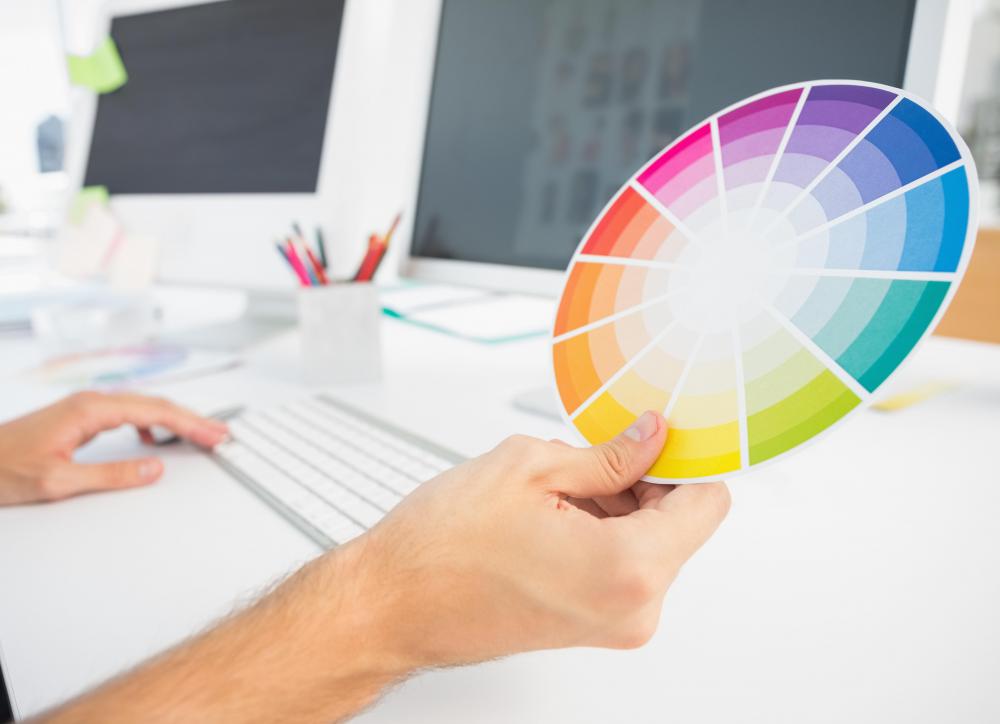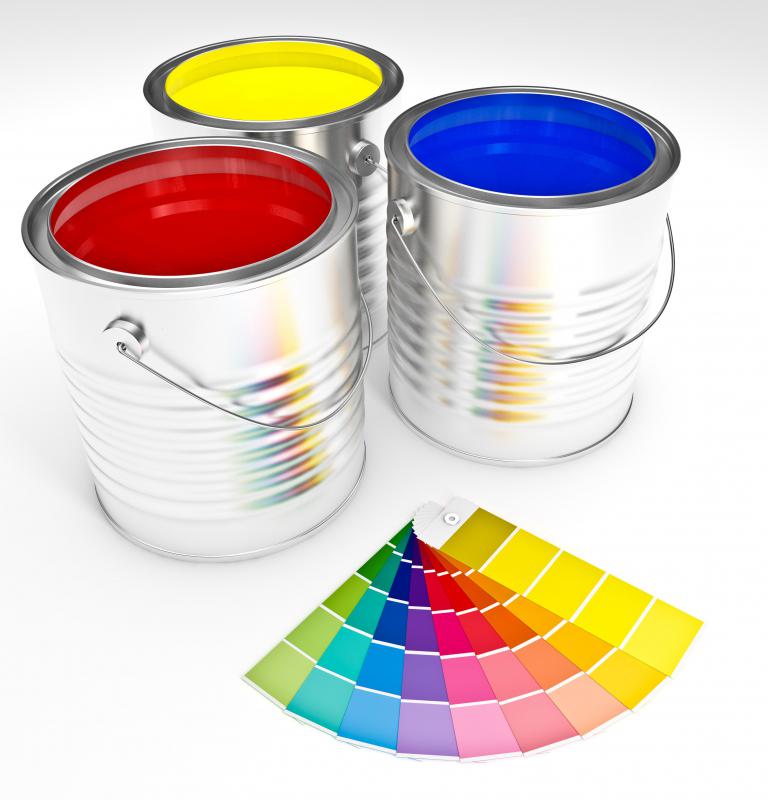At HomeQuestionsAnswered, we're committed to delivering accurate, trustworthy information. Our expert-authored content is rigorously fact-checked and sourced from credible authorities. Discover how we uphold the highest standards in providing you with reliable knowledge.
What is a Color Wheel?
A color wheel is disk-shaped and divided equally into 12 sections, each displaying a different color according to its "pigment" values.
All colors arise from the three primary colors: red, blue and yellow. These colors are primary because you cannot make them by mixing other colors together. They are represented on the color wheel at equidistant positions, forming a triangle.

Mixing equal values of any two primary colors together creates the secondary colors of violet, orange and green. Since violet is a combination of equal amounts of blue and red, it lies halfway between those two colors on the wheel. Orange lies halfway between red and yellow, and green between yellow and blue. The secondary colors form another triangle.

To fill the last 6 spaces on the wheel, the tertiary colors are represented. Adding equal amounts of one primary and one secondary color, or the colors to either side on the wheel, results in the tertiary colors between. Flanked by red and orange you will see red-orange, between orange and yellow, yellow-orange, followed by yellow-green, blue-green, blue-violet, and red-violet.
A color wheel is extremely handy when putting together a color scheme, or series of colors that will compliment each other to create an overall pleasing affect. Following are some basic color schemes:

Monochrome: A single color is used, varied in saturation and lightness for several different contrasting shades. Many "skins" for software use a monochromatic color scheme. One problem with this color scheme is that it is difficult to make anything stand out, and the lack of contrast can get monotonous.
Analogous : Here you use the wheel to pick two colors that are side-by-side. One becomes the dominant color and the other is used to accent. The overall effect is much like the monochrome scheme but offers more hues. However, it still lacks contrast.
Complimentary : Using the color wheel, complementary colors are found opposite each other. This creates high contrast. Again one of the two colors should be dominant. This color scheme is harder to balance in a pleasing way than the aforementioned schemes.
Split complementary: Same as the previous color scheme, however you would also use the two colors either side of the secondary complementary color. This mutes some of the starkness created by the previous scheme.
Triadic : As the name implies this color scheme uses any three colors which form a triangle on the wheel, equally spaced apart.
Tetradic (or double complementary) : In this case you pick a complimentary pair of colors (opposites), then a second pair to use in tandem. It's important to balance cool and warm colors for the right effect.
For picking color schemes for things like quilting, starting at any point on the wheel and counting off three to five colors adjacent to one another makes for an interesting combination that provides variety and contrast, while avoiding the harshness of complementary colors.
A color wheel is a handy tool for everyone from software programmers to interior decorators and hobbyists. The next time you need to pick a color scheme, consider picking up a color wheel first! You can also find them online.
AS FEATURED ON:
AS FEATURED ON:













Discussion Comments
Just so you know, artists today can make red with transparent yellow PY153 or PY100 and transparent magenta PR122. They make blue combining transparent cyan PB15 and Magenta PR122. Any color can be made using only these three transparent primary colors.
@turtlez - Thanks! I had heard of the CMYK and RGB hue color wheels, but didn't know what they were about and you explained it perfectly. I think I remember a professor of mine telling us to do something in Photo Shop in CMYK, but I did it in RGB and they didn't seem to notice. Funny how that works, huh? I mean, the colors must really be that similar.
@win199 - The CMYK and RGB colors really have more practical applications when using HTML color wheels or editors like Photo Shop. Not very many children know about the difference between CMYK and RGB. CMYK is normally used in a professional atmosphere and stands for Cyan, Magenta, Yellow, and Key (which is black) whereas RGB is, of course, Red, Green, and Blue. Most graphic designers choose to work in the CYMK colors because of the flexibility and variety.
What is the difference between CMYK and RGB colors? Do they have real world applications to young children as much as the regular color chart wheel thing?
Color wheels come in handy no matter what your age or profession. Many elementary schools actually have color wheel charts to help children understand that there are a lot of different colors out there. Furthermore, it goes way beyond just identifying colors, but discovering what colors other colors make when mixed together.
Post your comments